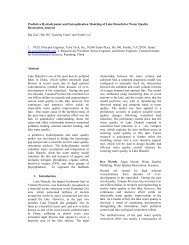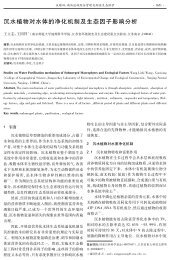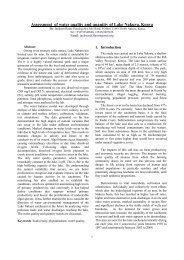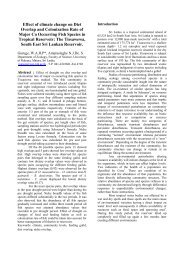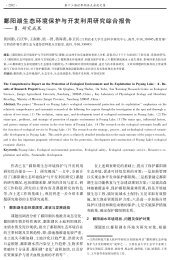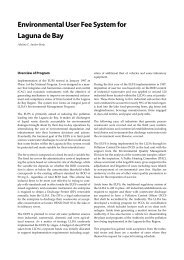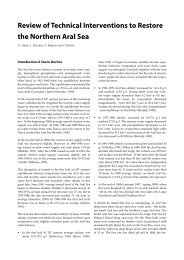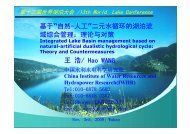Development of the U-50 Series Multi-parameter Water Quality ...
Development of the U-50 Series Multi-parameter Water Quality ...
Development of the U-50 Series Multi-parameter Water Quality ...
You also want an ePaper? Increase the reach of your titles
YUMPU automatically turns print PDFs into web optimized ePapers that Google loves.
dissolved oxygen (DO), pH, conductivity, ORP,water depth, and temperature is embedded into10-cm diameter probe base. The sensors forturbidity, DO, pH, and ORP are removable andeasy to replace.Membrane Cap3. Comparison <strong>of</strong> <strong>the</strong> U-20 and U-<strong>50</strong>Table 1 compares <strong>the</strong> specifications <strong>of</strong> <strong>the</strong> U-20and newly developed U-<strong>50</strong> series. As shown in <strong>the</strong>table, improvements were also made to eachmeasurement <strong>parameter</strong>. Significantimprovements were made particularly in <strong>the</strong>turbidity meter and dissolved oxygen electrode.The turbidity meter in <strong>the</strong> U-20 uses an LED as<strong>the</strong> light source with a 30 degree scatteringmethod. Meanwhile, <strong>the</strong> U-<strong>50</strong> series model U-53uses a tungsten lamp as <strong>the</strong> light source with a 90degree scattering method. This method complieswith <strong>the</strong> US EPA Method 180.1, and is strongagainst chromaticity differences while beinghighly sensitive to small particles. Prior to <strong>the</strong>measurement, <strong>the</strong> wiper can clean <strong>the</strong> sensorwindow to reduce <strong>the</strong> influences <strong>of</strong> air bubblesand dirt.The dissolved oxygen sensor on <strong>the</strong> U-<strong>50</strong> is basedon <strong>the</strong> polarographic method, whereas on <strong>the</strong>U-20 <strong>the</strong> galvanic battery system. This means <strong>the</strong>electrode can be lead-free, making it exempt <strong>of</strong>restrictions imposed by <strong>the</strong> European RoHSregulation. As shown in Figure 3, <strong>the</strong> oxygenisolation film is shaped like a cap. This allows <strong>the</strong>customer to replace <strong>the</strong> film simply by tightening<strong>the</strong> film cap. Additionally, <strong>the</strong> measurementrange was expanded.Table 2 shows potential new measuringapplications for <strong>the</strong> U-<strong>50</strong> series afforded by <strong>the</strong>seimprovements. The improved turbiditymeasuring accuracy enables measurement andcontrol <strong>of</strong> ground water, environmental water,and plant water with low turbidity. Turbiditysensors in previous multi-<strong>parameter</strong> waterquality checkers are not capable <strong>of</strong> measuring lowturbidity concentrations. Users who accustomedto measuring turbidity separately will appreciate<strong>the</strong> simplified and simultaneous measurement.The expanded measuring range for dissolvedoxygen enables measurement and control <strong>of</strong> highconcentrations <strong>of</strong> oxygenated water such asoxygen enriched drinking-water and <strong>the</strong>photosyn<strong>the</strong>tically-activated environment water.The expanded measuring range for conductivityenables measurement <strong>of</strong> high salinity samplessuch as seasonings solution in <strong>the</strong> food makingindustry.DO Sensor Main BodyFig.3 Structure <strong>of</strong> DO Sensor4. Measurement ExamplesThe changes in turbidity and dissolved oxygen asmeasured continuously over 12 days in Inba-pond,Chiba prefecture is shown in Figure 4. When webegan measuring on May 28, <strong>the</strong> turbidity was20.5 NTU and <strong>the</strong> COD value was 10.0 ppm. Theturbidity and COD value dropped during <strong>the</strong>measurement period and became 5.89 NTU and8.8 ppm, respectively, on <strong>the</strong> last day <strong>of</strong> June 9.This result suggests decrease in organic matter.The dissolved oxygen (DO) concentrationincreased from <strong>the</strong> morning to <strong>the</strong> afternoon, anddecreased from <strong>the</strong> evening to <strong>the</strong> followingmorning. This is <strong>the</strong> result <strong>of</strong> oxygen generated byphotosyn<strong>the</strong>sis in <strong>the</strong> afternoon, and oxygenconsumed by breathing during <strong>the</strong>night.Although traces <strong>of</strong> organic matter werefound on <strong>the</strong> measurement unit after 12 days <strong>of</strong>continuous measurement, <strong>the</strong> wiper kept <strong>the</strong> cellwindow on <strong>the</strong> turbidity meter in a clean state.



